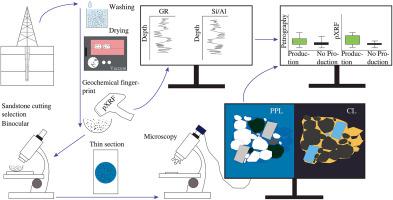钻屑储层表征及井产量代理分析——以奥地利维也纳盆地Flysch区块为例
IF 3.6
引用次数: 0
摘要
钻屑虽然很少使用,但却是了解影响储层质量的岩石学性质的关键地下样本。与岩心材料不同的是,岩屑沿着井筒持续存在,可以在钻井过程中监测钻井进度。因此,岩屑可以对地下的岩石属性进行半定量的统计校准,但它们通常没有得到充分利用。虽然不能从钻岩块中重建裂缝和静脉的方向,但可以使用透射光学显微镜和阴极发光技术来识别和分析特定地层剖面和深度的静脉及其内部结构(开放、部分封闭或封闭),以补充井场的特征,并随后评估生产行为。井眼伽玛射线测井结合手持式便携式x射线荧光(pXRF)对清洁和干燥的钻屑进行分析,可以进一步提高切割样品的深度精度,并根据Si/Al比值(作为井中富砂岩和富泥岩部分的代表)对样品进行地球化学指纹。在这项研究中,来自两口井的83个砂岩切割样本,覆盖了古新世-始新世Greifenstein Fm地层约400 m。对奥地利维也纳盆地的海绿石砂岩进行了等效研究。它们还覆盖了三个不同的水库部分区域(1)。为3。gl)。维也纳盆地的弗理石区发育多个砂泥岩互层,由多个推覆体组成,形成复杂的储层隔室。海绿石的含量在GLS的不同切片之间有所不同,其中在3.中观察到最高。gl。砂岩主要由铁方解石胶结,导致两口井的光学孔隙度较低(5%),只有个别孔隙度升高,这与部分溶解的钾长石颗粒有关。仅基于岩屑的共生序列进一步表明,研究剖面的储层质量与砂岩压实作用无关,但与细粒砂岩较低的光学孔隙度和较高的碳酸盐脉胶结物含量有关。此外,生产间隔与较低的Fe + Mg含量有关。了解储层性质、成岩作用及其对流体流动的影响对于成功勘探和减少储层生产开发中的不确定性至关重要。岩屑的成岩变化和pXRF的地球化学指纹与储层质量和单井射孔的生产动态有关。在无法获得岩心材料的情况下,这种方法可以提供有关储层质量的额外信息。本文章由计算机程序翻译,如有差异,请以英文原文为准。

Reservoir characterization and well production proxy analyses on drill cuttings: Case study from the Flysch play in the Vienna Basin (NE Austria)
Drill cuttings, though rarely used, are crucial subsurface samples to understand petrographic properties affecting reservoir quality. Unlike core material, cuttings are continuously available along the wellbore and can be used during drilling to monitor progress. Therefore, cuttings may allow a semi-quantitative, statistical calibration of rock properties from the subsurface, but they are often underutilized. Although fracture and vein orientations cannot be reconstructed from drill cuttings, the presence of veins and their internal textures (open, partially sealed or sealed) in specific formation sections and depths can be identified and analyzed using e.g., transmitted light microscopy and cathodoluminescence to supplement characterization at the well site and subsequently assess production behavior. Borehole gamma ray logs in combination with handheld portable X-ray fluorescence (pXRF) analyses on cleaned and dried drill cuttings can be used to further improve the depth accuracy of the cutting samples and to geochemically fingerprint the samples, based on the Si/Al ratio, as a proxy for sandstone-rich and mudrock-rich sections of the well. In this study, eighty-three sandstone cutting samples from two wells, covering ∼400 m of stratigraphy targeting the Paleocene-Eocene Greifenstein Fm. equivalent (Glauconite Sandstone, GLS) in the Vienna Basin (Austria), were studied. They also cover parts of three different reservoir sections (1. to 3. GLS). The Flysch play in the Vienna Basin hosts several sandstone-mudrock interbeds and is composed of several nappes, forming complex reservoir compartments. The glauconite contents vary between different sections of the GLS, where the highest is observed in the 3. GLS. The sandstones are predominantly cemented by ferroan calcite, resulting in low optical porosity (<5 %) in both wells, with only individually elevated porosity, related to partially dissolved K-feldspar grains. A paragenetic sequence solely based on cuttings further highlights that reservoir quality in the studied section is independent of sandstone compaction, but is related to lower optical porosity in finer-grained sandstones and higher carbonate vein cement contents. Furthermore, productive intervals are related to lower Fe + Mg contents. The understanding of reservoir properties, diagenesis, and their influence on fluid flow is crucial for successful exploration and reduction of uncertainty in reservoir production and development. The diagenetic variations from cuttings and the geochemical fingerprint by pXRF are linked to reservoir quality and production performance of individual well perforations. This approach can provide additional information on reservoir quality where core material is unavailable.
求助全文
通过发布文献求助,成功后即可免费获取论文全文。
去求助

 求助内容:
求助内容: 应助结果提醒方式:
应助结果提醒方式:


